The Enigmatic Shoebill Stork: Nature’s Most Stoic Predator
The shoebill stork, often described as a living relic of prehistoric times, is one of the most mesmerizing birds to walk the wetlands of Central Africa. With its cold, reptilian stare, immense beak, and statuesque posture, this formidable avian evokes awe and, sometimes, fear. Often trending on social media under “shoebill stork scary” or “shoebill stork next to person,” the species commands curiosity—and rightly so. Whether it’s the low, hollow resonance of a shoebill stork call, the rare sight of a flying shoebill stork, or simply the surreal image of a shoebill stork standing perfectly still, this bird offers a spectacle unmatched in the avian world.
Table of Contents
Scientific Classification
- Kingdom: Animalia
- Phylum: Chordata
- Class: Aves
- Order: Pelecaniformes
- Family: Balaenicipitidae
- Genus: Balaeniceps
- Species: Balaeniceps rex
Description / Physical Description
The shoebill stork is instantly recognizable due to its enormous, shoe-shaped bill. Measuring up to 9.4 inches long and 4.3 inches wide, this massive beak is pale gray with darker mottling and ends in a sharply hooked tip—perfect for snaring prey. The shoebill stork height can reach 4 to 5 feet tall, with a wingspan extending 7.5 to 8.5 feet.
Despite being dubbed a stork, it bears more anatomical similarity to pelicans and herons. Its plumage is slate-blue with metallic undertones, contributing to its ghostly appearance. When observing a shoebill stork standing, its stillness can appear almost statuesque—a technique it uses while hunting.
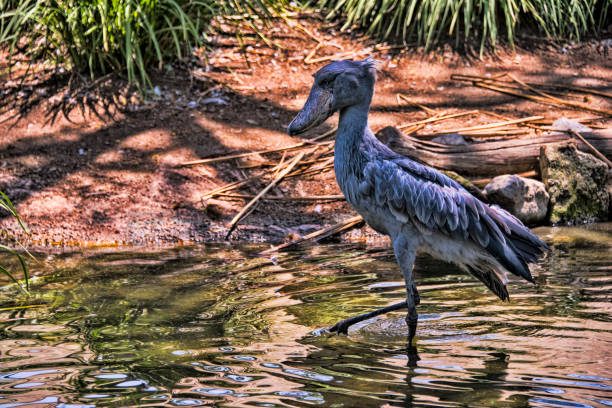
Range & Distribution
The species is endemic to the freshwater swamps and wetlands of Central and East Africa. Countries such as South Sudan, Uganda, Tanzania, the Democratic Republic of Congo, and Zambia are prominent strongholds. Shoebills are most abundant in remote and inaccessible regions where human activity is minimal.
For those wondering, “where can I see a shoebill stork?“—Uganda’s Mabamba Swamp is the most reliable destination. However, if you’re asking, “where can I see a shoebill stork in America?” the answer is more limited. A handful of zoos and sanctuaries—such as Zoo Tampa at Lowry Park—occasionally host them in captivity, though sightings are rare.
Habitat
The shoebill prefers papyrus swamps, reed beds, and poorly oxygenated wetlands with floating vegetation. These stagnant ecosystems are rich in lungfish and amphibians, making them ideal hunting grounds. Their preferred habitats are often far removed from populated areas, allowing these solitary birds to thrive in peace.
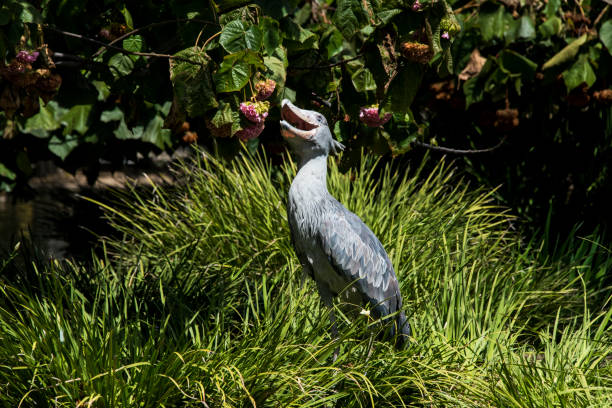
Diet
The shoebill is a carnivorous ambush predator with a diet dominated by large, slippery prey. Their primary food source is the African lungfish (Protopterus spp.), but they also consume:
- Eels
- Tilapia
- Catfish
- Frogs
- Snakes
- Baby crocodiles
- Small waterfowl
Hunting involves silent stillness. The bird waits motionless until the moment is right—then strikes with swift, brutal precision. After capturing its prey, it decapitates or crushes it using the beak’s hook-like edge.
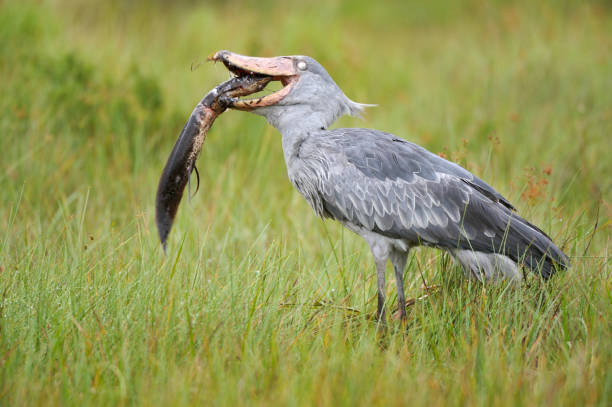
Behaviour / Lifestyle
Shoebills are solitary birds, fiercely territorial and typically seen alone outside the breeding season. Their daily routine is largely silent and methodical. They spend hours waiting in ambush, relying on patience and their acute sense of sight.
Perhaps the most eerie feature of their behavior is the shoebill stork sound—a bill-clattering vocalization that resembles machine-gun fire. This shoebill stork call is most often heard during greetings or courtship and is paired with deep croaks or moos in juveniles.
Despite their awkward size, a flying shoebill stork is a graceful sight. With slow, deliberate wingbeats, they soar through the humid air, though they rarely fly long distances.
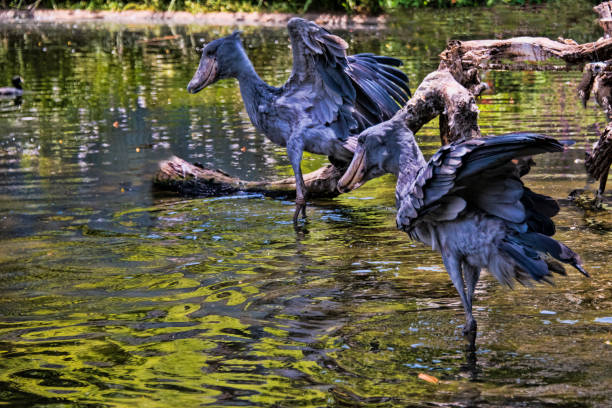
Lifespan
In the wild, the shoebill stork has a lifespan of 35 to 40 years. In captivity, with medical care and consistent food supply, some have lived beyond 50 years. Their longevity, however, comes at the cost of a slow reproductive rate and delayed maturity.
Adaptations
Several adaptations allow shoebills to survive in harsh wetland environments:
- Beak morphology: The massive bill isn’t just for show—it’s specialized for seizing and subduing slippery or armored prey.
- Stealth hunting: Their slow, quiet movements reduce disturbances, making them highly effective ambush predators.
- Hypermobile neck vertebrae: This allows for sudden, whiplash-like strikes.
- Long legs and toes: Ideal for balancing on floating vegetation while stalking prey.
- Gray-blue coloration: Offers camouflage in shadowy swamps and dense reed beds.
Mating & Reproduction / Reproduction & Lifecycle
Shoebill storks form monogamous pairs during the breeding season, which coincides with the dry season when water levels are low and food is concentrated. Together, they construct nests up to 3 feet wide using grasses and aquatic vegetation.
The female lays 1–3 eggs, but usually, only one chick survives—a result of obligate siblicide where the stronger chick kills its sibling. This brutal practice, while unsettling, ensures the survival of at least one baby shoebill stork.
Both parents take turns incubating the eggs for around 30 days. Chicks fledge at approximately 3 months but may remain dependent for another month.
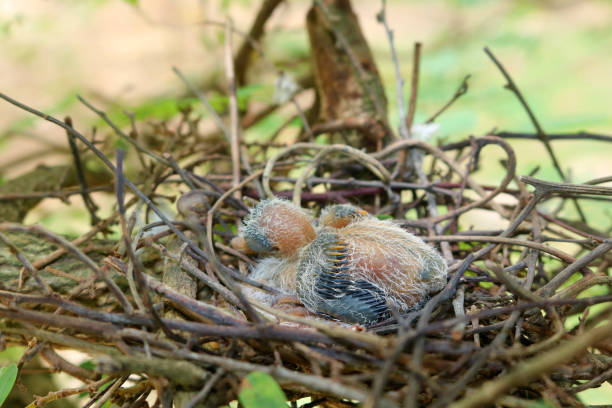
Predators
Adult shoebills face few natural predators due to their size and aggression. However, eggs and young chicks are vulnerable to:
- Marabou storks
- Monitor lizards
- Crocodiles
- African fish eagles
Human encroachment and habitat degradation are increasingly dangerous, though indirect.
Conservation Status
The IUCN classifies the shoebill stork as Vulnerable. With fewer than 10,000 mature individuals remaining, the population trend is declining.
Primary threats include:
- Wetland drainage for agriculture
- Illegal pet trade
- Disturbance from ecotourism
- Climate change impacting wetland hydrology
Conservation efforts are underway in Uganda and Zambia, focusing on community engagement, habitat protection, and anti-poaching patrols.
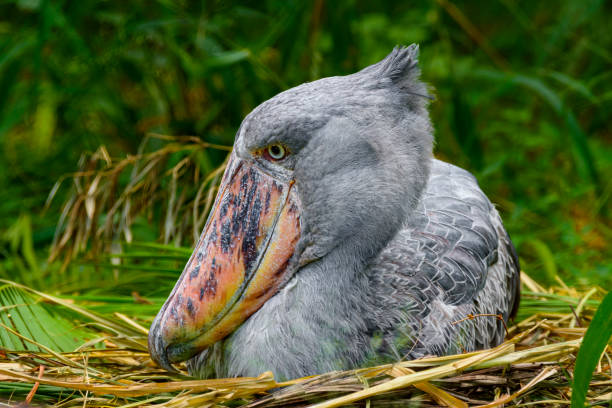
Interesting Facts
- The shoebill stork scary reputation comes from its fixed gaze and aggressive behavior during feeding and nesting.
- Their prehistoric look earns them nicknames like “dinosaur bird” or “whalehead.”
- They can stand motionless for hours, earning the title “statue bird.”
- Their beak can exert enough force to kill baby crocodiles with one bite.
- A shoebill stork next to person can seem taller than a child, making the comparison both fascinating and intimidating.
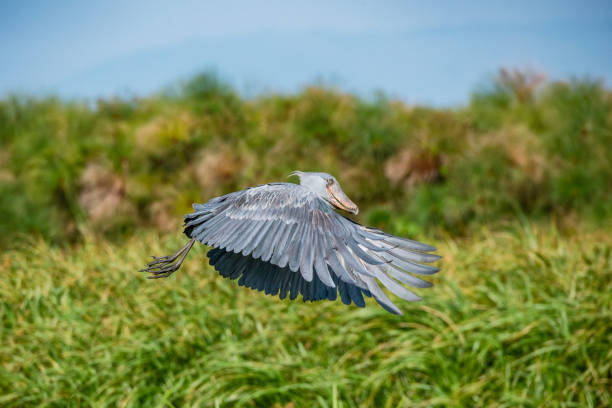
As Pets
Despite their allure, shoebill storks are unsuitable as pets. They are protected by international law (CITES Appendix II), have specialized dietary needs, and require vast, swampy habitats to thrive. Captive birds are typically housed only in large zoological institutions with the expertise and permits to care for them.
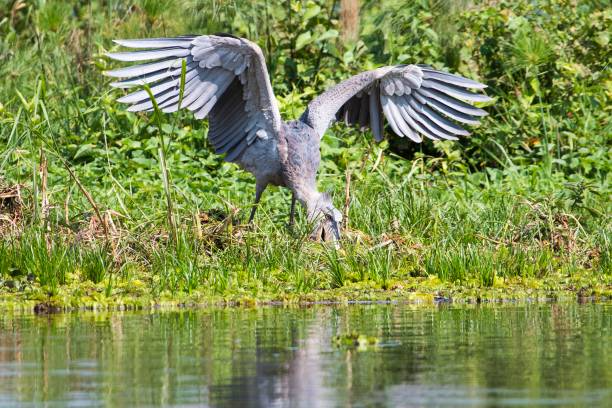
Classification of Species
Shoebill storks are currently monotypic—there is only one species, Balaeniceps rex, within the genus Balaeniceps. While their taxonomic placement has shifted over time, molecular studies confirm their closeness to pelicans and herons, rather than true storks.
Subspecies
There are no recognized subspecies of the shoebill stork. Its distribution is continuous enough across Central Africa to maintain genetic homogeneity, and no significant morphological or behavioral variations have been observed that would warrant subspecific classification.
The shoebill stork remains a hauntingly beautiful paradox—prehistoric yet modern, intimidating yet magnetic. Whether admired from afar in the swamps of Uganda or glimpsed in a zoo exhibit, it leaves an indelible impression on all who encounter it.


